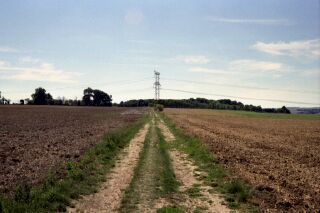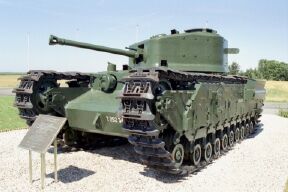
HILL 112

Hill 112, August 2001
"Immediately south of Fontaine Etoupefour for about 2,000 yards completely open cornfields rose very gradually up to the ridge, which follows generally the line from Pt. 112 to Eterville. Point 112 itself is a slight rise on the top of the plateau with very gentle slopes. It completely commands both the valleys of the Odon and the Orne. It is, however, itself most conspicuous. Close by it on the reverse slope is a small copse, later to earn the name of ‘Cornwall’ wood. Where the track from Baron crosses the main road from Evrecy stood a crucifix, the Croix de Filandrières, and north of it an orchard surrounded by a tree-lined hedge. Waist high corn, red with poppies, stretched north-eastwards past the ruins of Chateau de Fontaine to the southern fringe of the large straggling village, much overgrown with trees and orchards, of Eterville. A 1,000 yards to the south, also surrounded by orchards, lay the village pf Maltot in a valley close to the Orne.
The enemy… still held the high ground immediately east of the Orne. From here his F.O.O.s, both artillery and mortar, still retained perfect observation of all movement on and over the slopes of Hill 112 and the ridge above Maltot. The Division was therefore about to assault a position of great strength which gave every advantage to the defender. Until the high ground east of the Orne was captured the enemy could manoeuvre his Tigers and Panthers unseen south of the ridge and observe our every movement south of the enclosures between Fontaine Etoupefour and Baron."
Major-General H.Essame The 43rd Wessex Division at War 1944-1945 p.36-37.
Hill 112 has often been called the 'Verdun of Normandy'. It was here that the British breakout came to a halt, following the crossing of the Odon, and the fighting around the high ground of the infamous Hill absorbed several British formations during the summer of 1944. During two days fighting alone, 10th-11th July 1944, the 43rd (Wessex) Division suffered more than 2,000 casualties, and the slopes of the Hill were ablaze with the wrecks of British tanks (largely Churchills) knocked out by the SS Panzer units in occupation of the high ground. Hill 112 was not finally cleared until 3rd August, during the final phase of the breakout from Normandy. By that time the crest of the hill had been turned into a vast crater-zone of shell holes, wrecked vehicles and the bodies of those who had fought and died here.

Churchill Tank, Hill 112.
Hill 112 acquired the name "Cornwall Hill" because 5th DCLI suffered 320 casualties in the fighting here. The 92 fatalities from this unit were buried on the hill after the battle, until their graves were moved after WW2.
Hill 112 Today
The layout of the Hill has changed little since 1944. It still dominates the ground in this part of the battlefield. The 43rd (Wessex) Division Old Comrades Association erected a memorial here, and in the year 2000 an orientation plaque, and Churchill tank were also placed on the site.

Memorial to 43rd (Wessex) Division on Hill 112.
©PAUL REED 2002-2006
![]()